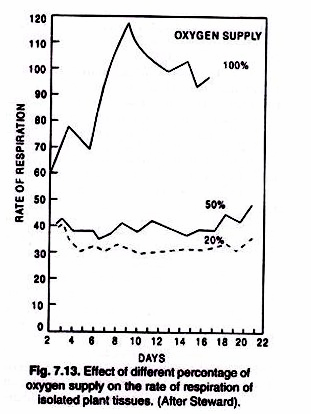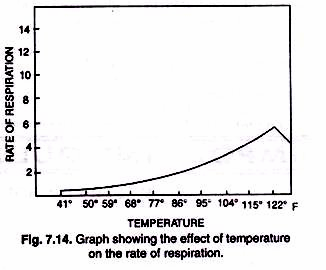The following eight points will highlight the eight major factors affecting aerobic respiration in Plants.
The eight environmental factors effecting the rate of respiration are: (1) Oxygen Content of the Atmosphere (2) Effect of Temperature (3) Effect of Light (4) Effect of Water Contents (5) Effect of Respirable Material (6) Effect of Carbon Dioxide Concentration (7) Protoplasmic Conditions and (8) Other Factors.
(1) Oxygen Content of the Atmosphere:
The percentage of oxygen in the surrounding atmosphere greatly influence the rate of respiration. But reduction of the oxygen content of the air, however, causes no significant lowering in the respiratory rate until the percentage drops to about 10%. At 5% oxygen definite retardation of respiration occurs.
As shown in the graph (Fig. 7.13), with the increase of oxygen concentration in the atmosphere, the rate of respiration also increases, but this effect is not as accelerating as might be expected. This response of plants and their parts depends upon several factors. The plant tissues which ordinarily have low rate of respiration are not as seriously effected by low concentration of oxygen as those which have higher rate of respiration.
In certain plants, like rice, on removal of oxygen the rate of respiration in terms of total carbon dioxide produced actually increases. This indicates that anaerobic respiration comes into action when oxygen is no longer available and that the plant, if it has to make up for the relative inefficiency of this system, has to respire faster.
(2) Effect of Temperature:
Like most chemical reactions, the rate of respiration is greatly influenced by temperature. Estimation of Q 10 of the process for a rise in temperature from 8° to 18 °C gives a Q 10 of 2, indicating a chemical reaction. If the rise is at a much higher starting temperature, say between 20° and 30°C, then the Q 10 may fall below 2. It should be borne in mind that different plants or plant parts may show considerable variation in regard to optimum temperature for respiration.
In certain cases the rate of respiration increases at lower temperature. E. F. Hopkins (1925) reported that the rate of respiration in white potatoes increases if the temperature in lowered to just above freezing point. This increase in the rate of respiration is primarily due to increase in the quantity of respirable materials (such as soluble carbohydrates) which tend to accumulate in Irish potato at temperature slightly above 0°C.
At temperatures higher than the optimum for respiration, the rate of respiration (in terms of oxygen utilized and CO2 produced) falls due to inter-conversions of respirable materials. For instance, fats may be formed from carbohydrates by a reaction in which carbon dioxide is utilized and oxygen produced. At very high temperatures, the rate of respiration falls significantly and may even come to standstill because of protoplasmic injuries (Fig. 7.14).
(3) Effect of Light:
Light has indirect effects on the rate of respiration. With the increase in light intensity, the temperature of the surrounding atmosphere also increases thus affecting the rate of respiration. Secondly, the quantity of respirable material in the plant largely depends upon the rate of photosynthesis which is directly influenced by light and thirdly, stomata remain open during daylight and hence rapid exchange of gases takes place through them.
(4) Effect of Water Contents:
Over a certain range, water content of the plant tissue greatly influence its rate of respiration. In most of the storage able seeds the moisture content is kept below the point which allows a rapid respiration. With the increase in moisture content, the rate of respiration is likely to go up with the result a rapid loss of viability will occur and at the same time the temperature will also rise and the grain may be spoiled (Fig. 7.15).
Unlike most green tissues, xerophytes, lichens and leafy mosses (Sphagnum species) can be brought to an air-dry condition at low humidity without any apparent loss in their viability.
(5) Effect of Respirable Material:
Amount and kind of respirable material present in the cells greatly effect the rate and course of respiration. It has been shown that plants respire more rapidly after having been exposed to conditions favourable for photosynthesis during which carbohydrates are synthesized. Increase in respiration has also been observed to be associated with increase in soluble sugars.
(6) Effect of Carbon Dioxide Concentration:
The rate of respiration is normally not affected by increase of carbon dioxide concentration in the surrounding atmosphere up to 19%, but as the concentration increases from 10% to 80%, a progressive decrease in respiration occurs.
Specific response to higher CO2 concentration varies with the particular kind of tissue and plant. The effect of CO2 concentration is more significant when the temperature and oxygen supply are low. At a very high concentration of CO2 the plant tissues are injured or even killed.
(7) Protoplasmic Conditions:
The young growing tissues which have greater amount of protoplasm as compare to older tissues, show higher rate of respiration. Their higher rate of respiration support the meristematic activities of the cells by supplying large amount of energy. The degree of hydration of the protoplasm in the cells affects the rate, and mechanical injury to plant tissues will accelerate respiration.
(8) Other Factors:
Various chemicals, such as cyanides, azides and fluorides, have been reported to possess respiration retarding properties through their effect on respiratory enzymes. Respiration rate may likely be accelerated by low concentrations of the compounds like ethylene, carbon monoxide, chloroform and ether.
Chlorides of various minerals, like sodium, potassium, calcium and magnesium have pronounced effect on the rate of respiration. Monovalent chlorides, like KCl and NaCl, increase the rate of respiration while the divalent chlorides, such as MgCl2 and CaCl2 greatly decrease it. Steward and Preston (1941) found cations to depress respiration and photosynthesis.


